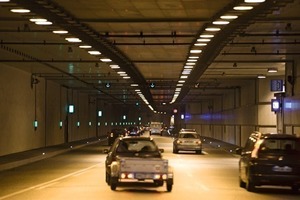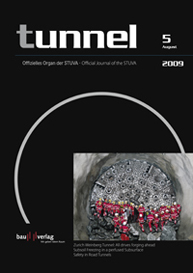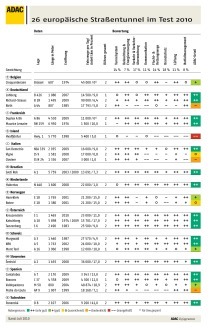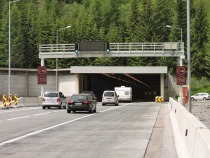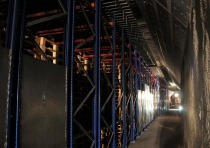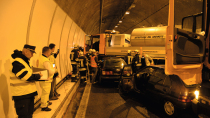Safety in Road Tunnels
Tunnels throughout Europe are tested each year within the scope of the ADAC Tunnel Test. As a result a data bank has been created containing details on safety in numerous tunnels. The results of this year’s test were announced recently and are presented in the following.
The ADAC Tunnel Test, which is executed in conjunction with EuroTAP [1], the European Tunnel Assessment Programme, was not as extensive this time around as at present European tunnels are undergoing an unprecedented phase of construction in order to adapt them to the requirements of the 2004 EU guideline [2]. Clearly a test serves no purpose when building is in progress. As a result only 13 Euro-pean tunnels were scrutinised during the 11th year that the Tunnel Test took place [3, 4].
Once again the length and significance for travellers were the criteria for selecting the tunnels that were tested. In Germany these were solely urban tunnels and in Switzerland tunnels on important routes leading to skiing districts. These tunnels belong neither to the Trans-European transport network (TERN) [2] nor to the Swiss national highway grid; as a consequence EU guidelines although being an important factor are not binding.
As in previous years the ADAC commissioned the Deut-sche Montan Technologie GmbH (DMT) with undertaking the test, examining the tunnels at source between January 20th and February 5th, 2009 in collaboration with the responsible national automobile associations, clarifying safety aspects together with operators and scrutinising corresponding documents. Operators were supplied in advance with a list of data pertaining to the most essential technical parameters.
Assessment Criteria
A checklist drawn up by the ADAC and the DMT served as the basis for evaluation. It relates to the codes of practice for road tunnels in Germany [5], France, the United Kingdom, Austria and Switzerland [6] as well as the European guidelines pertaining to minimum demands for safety in tunnels on the Trans-European highway network [2]. The checklist is revised annually and is split up into 8 categories possessing varying degrees of significance:
– Tunnel system (14 %)
– Lighting and energy supply (7 %)
– Traffic and traffic monitoring (17 %)
– Communication such as radio, loudspeakers and emergency call facilities (11 %)
– Escape and rescue paths (14 %)
– Fire protection (18 %)
– Ventilation (11 %)
– Emergency management (8 %).
Each criterion is assessed and receives a certain number of points. The total sum provides the safety potential of a tunnel. It describes all constructional and organisational measures, which are intended to avoid emergencies or restrict them.
The result is compared with the risk potential for motorists. How great is the probability of an accident occurring in the tunnel and what can this ensue? Towards this end the following aspects are taken into account:
– Tunnel length (1 to 6 points)
– Traffic frequency in the case of one-way and two-way traffic (1 to 10 points)
– The proportion of lorries (max. 8 points)
– Transportation of hazardous goods (max. 5 points)
– Greatest longitudinal incline of the tunnel (max. 3 points)
– Additional dangers posed by the tunnel (max. 3 points)
The points that are awarded are added up to provide the following risk assessment: very low (1 to 9 points), low (10 to 14 points), average (15 to 21 points), high (22 to 28 points) and very high (29 or more points).
The safety and risk potentials for a tunnel are added together to arrive at the overall assessment for a tunnel with certain safety measures depending on the existing risk parameters. In this way it is possible to compare tunnels with one another. The ratings “very good”, “good”, “adequate”, “critical” and “sub-standard” are generally applied (Table 1).
If a tunnel is assessed overall positively (in other words “very good”, “good” or “adequate”) all 8 safety potential categories should be evaluated positively. Otherwise the so-called k.o. criterion is applied so that the total rating cannot exceed “adequate”. This especially relates to escape and rescue paths as well as ventilation.
2009 Tunnel Test
During the first 2 months of this year the ADAC tested 13 tunnels in 4 countries [3, 4] together with DMT experts and its partner associations – namely 4 each in Germany, Spain and Switzerland as well as 1 in Croatia. The tunnels possess a total length of 25.7 km with 7 of them having a single tube (54 %) and 6 (46 %) two tubes – with lengths of 18 km (71 %) and 8 km (29 %) respectively. The lengths of the individual tunnels ranged from 800 m to 5.2 km averaging around 2 km. With the exception of 5, all tunnels opened after 2000 possess 2 tubes (Table 1). The tunnels investigated were used by a total of more than 310,000 vehicles per day (max. 109,000 for one tunnel) with on average 7.2 (max. 20 %) of them being lorries. Ge-nerally speaking the incidence of accidents rises with greater traffic volumes and tunnel lengths.
Test Results
The 13 tunnel tubes that were tested generally resulted in positive ratings. No less than 9 tunnels were awarded “very good”, 3 “good” and even the poorest in the test was given an “adequate” rating. As a consequence the ADAC Tunnel Test attained the best result of its 11-year history [7-16].
The Warnow Tunnel (2003) in the north east of Germany links the 2 banks of the Warnow in Rostock; it is the country’s first privately run tunnel and thus tolls are the order of the day. It can serve as an example. The 2 tubes are monitored 24/7 via video from a control centre manned with regularly trained personnel with an image automatically displayed in the event of incidents and emergency call facilities and fire extinguishers set up every 150 m. An automatic fire alarm system ensures that properly dimensioned ventilation is switched on, the tunnel closed and the fire brigade informed. This is equally well trained and equipped and works in harmony with the tunnel staff, something that has been shown on a regular basis through joint emergency drills. The well marked escapeways and the cross-passages leading to the other tube together with well distinguished emergency exits ensure effective self-rescue.
The Tegel Airport Tunnel in Berlin, which undercrosses the take-off and landing runways, has become an ultra-modern urban and motorway tunnel (Fig. 1) thanks to a thorough renovation scheme. In spite of a high volume of vehicles and daily tailbacks the tunnel achieved a “very good” rating by dint of its permanently manned control centre (Fig. 2) and optimal fire protection [17]. The Brudermühl Tunnel in Munich (Fig. 3) received the same rating (with up to 109,000 vehicles per day this is the tunnel with the greatest traffic frequency in the test) – with2 extremely bright tubes with sufficiently wide lanes and breakdown bays at short intervals in fact set 60 m apart as well as modern video monitoring (Fig. 4).
The Vue-des-Alpes Tunnel near La Chaux-de-Fonds in Switzerland awarded an “adequate” rating, is a 2-way facility with a high traffic volume and weak lighting. There are no loudspeakers in the tunnel nor is there a height check at the portals; cameras for video monitoring as well as emergency calls, fire extinguishers and hydrants are only to be found every 300 m. The escapeways are not properly marked and the gaps between emergency exits too large. What determined the poorer assessment, however, was the fact that the escape shelters do not possess a second exit, signifying that a lengthy stay in them in the event of fire can become critical.
“Very good” following Retrofitting
Two of the tunnels which were assessed to be “sub-standard” during an earlier test were checked out once more. They are now rated as “very good” thanks to the efforts on the part of the operators to improve the safety level of their tunnels:
M The Spanish Vielha Tunnel (5.2 km making it the longest in the test) was provided with a new tube (Juan Carlos I) and proved to be the first tunnel tested in EuroTAP history to be provided with an ultra-modern stationary sprinkling water extinguishing system. The old tunnel tube (Alfonso XIII) is used as an escape and rescue tunnel. By equipping the tunnel control centre with super-modern monitoring technology the prior conditions for reliable safety management were created.
M The safety concept for the Tunnel Tuhobic´ near Rijaka in Croatia was also substantially improved thanks to the second tube being opened so that an escape opportunity into the other tube is available in the event of fire. The ventilation in case of fire was also enhanced, video monitoring and end barriers installed as well as the tunnel’s own fire brigade set up.
Downgrading according to k.o. Criterion
Two tunnels were downgraded in accordance with the k.o. criterion from “very good” to “good” on account of a sub-standard category. Otherwise the overall result for 2009 would have been even better.
– The Schlossberg Tunnel in Heidelberg was affected by the tunnel system category on account of its only 2.85 m wide lanes and its narrow emergency paths of only 50 cm. Further-more there are neither breakdown bays nor continuous hard shoulders. The tunnel was built as a railway tunnel back in 1862 and was converted to accommodate road traffic in 1968. It has been retrofitted technically in recent years.
– The ventilation category influenced the Spanish Piqueras Tunnel (2008) near Soria because the almost 2.5 km long tunnel with 2-way traffic possesses a conventional longitudinal ventilation system, with the natural longitudinal current remaining unconsidered and insufficiently supervised in the event of fire, something that can lead to the whole tunnel filling up with smoke.
The most frequent Faults in the Test
Loudspeakers were missing in almost 50 % of cases by means of which motorists are informed about particular incidents and provided with instructions while passing through the tunnel. In just as many cases dark tunnel walls gave the impression of a rather subdued atmosphere. Barriers for closing the tunnel were missing in almost 1/4th of them and/or information panels in front of the portals, radio contact was not continuously available for all the emergency services or the fire service required too much time to reach the spot. In 2 Swiss tunnels the distance between emergency exits (up to 560 m) is too excessive.
Outlook
In order to retrofit tunnels according to schedule in keeping with the European guideline, considerable sums of money are being spent, e.g. 570 mill. euros in Germany for federal highway tunnels (300 mill. for operating technology and 270 mill. euros for construction technology involving escapeways, breakdown bays etc.) and in Switzerland more than 470 mill. euros up until 2012.
The outcome of this tunnel test indicates the great necessity for action on the part of tunnel operators. Recommendations are provided for them and tips on how to conduct oneself while driving through a tunnel given for motorists as well as on how to cope with irregularities (tailbacks, breakdowns, accidents and cases of fire).

